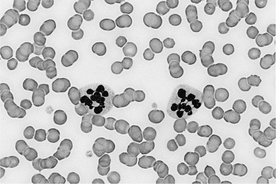10 INTERPRETATION OF THE LEUKOGRAM
5 What is a right shift?
The term right shift describes increased numbers of hypersegmented neutrophils, with five or more nuclear lobes. Hypersegmented neutrophils are not specifically included in the leukocyte differential count, so right shifts are not quantitated like left shifts. Hypersegmentation of neutrophils usually occurs as an aging change, when neutrophils circulate in blood for a longer time. Right shifts occur most often in animals (especially dogs) on glucocorticoid therapy or with hyperadrenocorticism, since glucocorticoids inhibit the emigration of neutrophils from blood vessels and prolong their circulation. Rarer causes of hypersegmentation are developmental disorders of neutrophils, such as erythroid macrocytosis of poodles, vitamin B12 maladsorptive disorder in giant schnauzers, myelodysplasia in animals with myelogenous leukemia, and benign idiopathic neutrophil hypersegmentation in horses (Figure 10-1).
9 What is a physiologic leukogram?
The physiologic leukogram typically occurs in young (<12 months of age) animals, although it is least likely to occur in dogs. The leukocyte changes are mediated by epinephrine during the “fight or flight” response that occurs with excitement, fear, or anxiety or with physical exertion, including parturition or convulsions. The distinguishing feature of the physiologic leukogram is lymphocytosis. The lymphocytosis is attributed to increased entry of lymphocytes into blood, presumably from splenic contraction and muscular activity that enhance the lymphatic and thoracic duct flow of lymphocytes into blood. A mature neutrophilia is also present, caused by demargination of blood neutrophils. The increased cardiac output and blood flow apparently sweep neutrophils from the marginal pool into the circulating neutrophil pool. Minimal changes occur in monocyte, eosinophil, and basophil concentrations. The physiologic leukogram is observed infrequently, in part because this leukocytosis resolves within 30 minutes.
Stay updated, free articles. Join our Telegram channel

Full access? Get Clinical Tree



